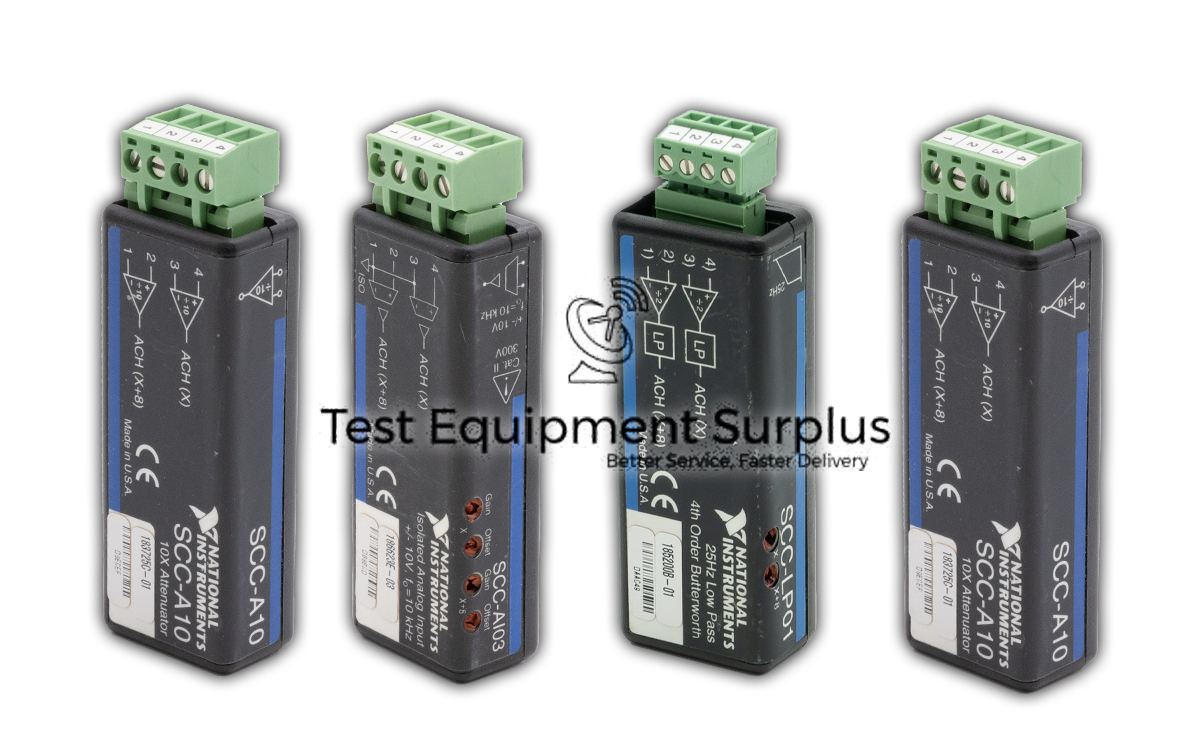Description
The NI SCC-TC01 Thermocouple Input Module (Part Number: 777459-03) is designed to condition signals from thermocouples with an input range of -100 mV to +100 mV. It operates optimally between 15 to 35 degrees Celsius and requires a power supply of 60 mW at 25°C. This module features a single channel and is equipped with a 2-prong uncompensated thermocouple jack that supports both miniature and subminiature male two-prong thermocouple plugs.
With a low-pass filter set at 2 Hz and an instrumentation amplifier gain of 100, the SCC-TC01 ensures precise signal amplification and noise reduction. Additionally, it provides buffered outputs to support maximum scanning rates, enhancing data acquisition efficiency. The module also includes an onboard thermistor for accurate cold-junction compensation.
Designed with safety in mind, the SCC-TC01 offers overvoltage protection up to +42V and maintains a maximum gain error of +0.08% of reading. The maximum input working voltage for this module is +12 Volts, making it a robust choice for various thermocouple measurement applications.
| Specification | Detail |
|---|---|
| Part Number | 777459-03 |
| Product Name | NI SCC-TC01 Thermocouple Input Module |
| Number of Channels | 1 |
| Input Range | -100 mV to +100 mV |
| Power Requirement | 60 mW (at 25°C) |
| Optimal Operating Temperature | 15 to 35 degrees Celsius |
| Thermocouple Jack | 2-prong uncompensated |
| Supported Thermocouple Plug Types | Miniature male two-prong, Subminiature male two-prong |
| Low-Pass Filter Frequency | 2 Hz |
| Instrumentation Amplifier Gain | 100 |
| Buffered Outputs | Supports maximum scanning rates |
| Onboard Thermistor | For cold-junction compensation |
| Overvoltage Protection | Up to +42V |
| Gain Error | Maximum value +0.08% of reading |
| Input Working Voltage | +12 Volts maximum |
Question 1: What are the key features and specifications of the NI SCC-TC01 Thermocouple Input Module, including its optimal operating temperature, power requirements, and signal conditioning capabilities?
Answer 1: The maximum input working voltage for the NI SCC-TC01 Thermocouple Input Module is +12 Volts, and its onboard thermistor benefits thermocouple measurement applications by providing accurate cold-junction compensation, which is essential for precise temperature readings.
Question 2: What is the function of the onboard thermistor included in the NI SCC-TC01 Thermocouple Input Module with Part Number 777459-03?
Answer 2: The operational temperature range for the NI SCC-TC01 Thermocouple Input Module is 15 to 35 degrees Celsius, and it requires a power supply of 60 mW at 25°C.
Question 3: What type of thermocouple plug does the NI SCC-TC01 Thermocouple Input Module support and what is its part number?
Answer 3: The NI SCC-TC01 Thermocouple Input Module supports both miniature and subminiature male two-prong thermocouple plugs and has the part number 777459-03.
Question 4: What is the operational temperature range and the power supply requirement for the NI SCC-TC01 Thermocouple Input Module?
Answer 4: The onboard thermistor included in the NI SCC-TC01 Thermocouple Input Module with Part Number 777459-03 is designed to provide accurate cold-junction compensation, which is essential for precise temperature measurement with thermocouples.
Question 5: What is the maximum input working voltage for the NI SCC-TC01 Thermocouple Input Module, and how does its onboard thermistor benefit thermocouple measurement applications?
Answer 5: The NI SCC-TC01 Thermocouple Input Module is equipped with key features including a thermocouple input range of -100 mV to +100 mV, an optimal operating temperature range of 15 to 35 degrees Celsius, power requirements of 60 mW at 25°C, and signal conditioning capabilities such as a low-pass filter at 2 Hz, an instrumentation amplifier gain of 100 for precise signal amplification, buffered outputs for enhanced scanning rates, onboard thermistor for accurate



